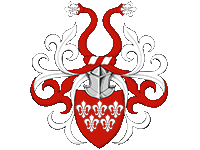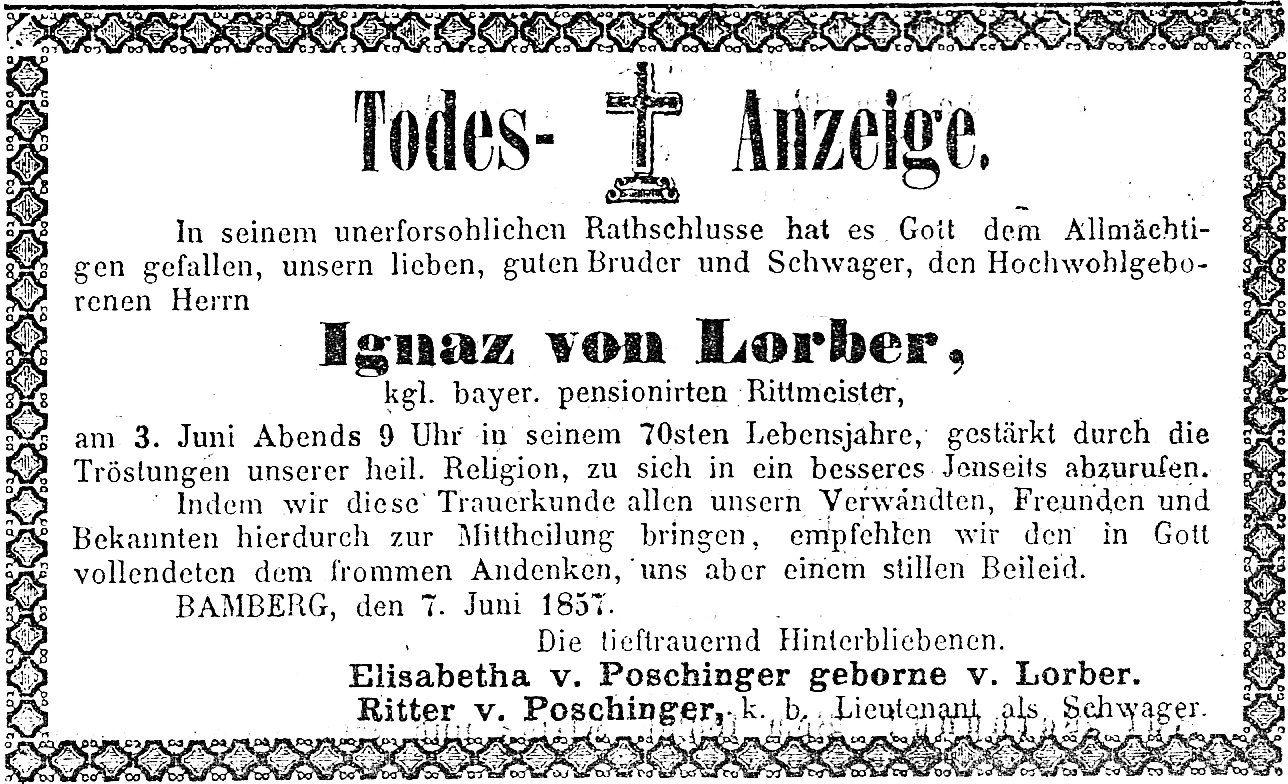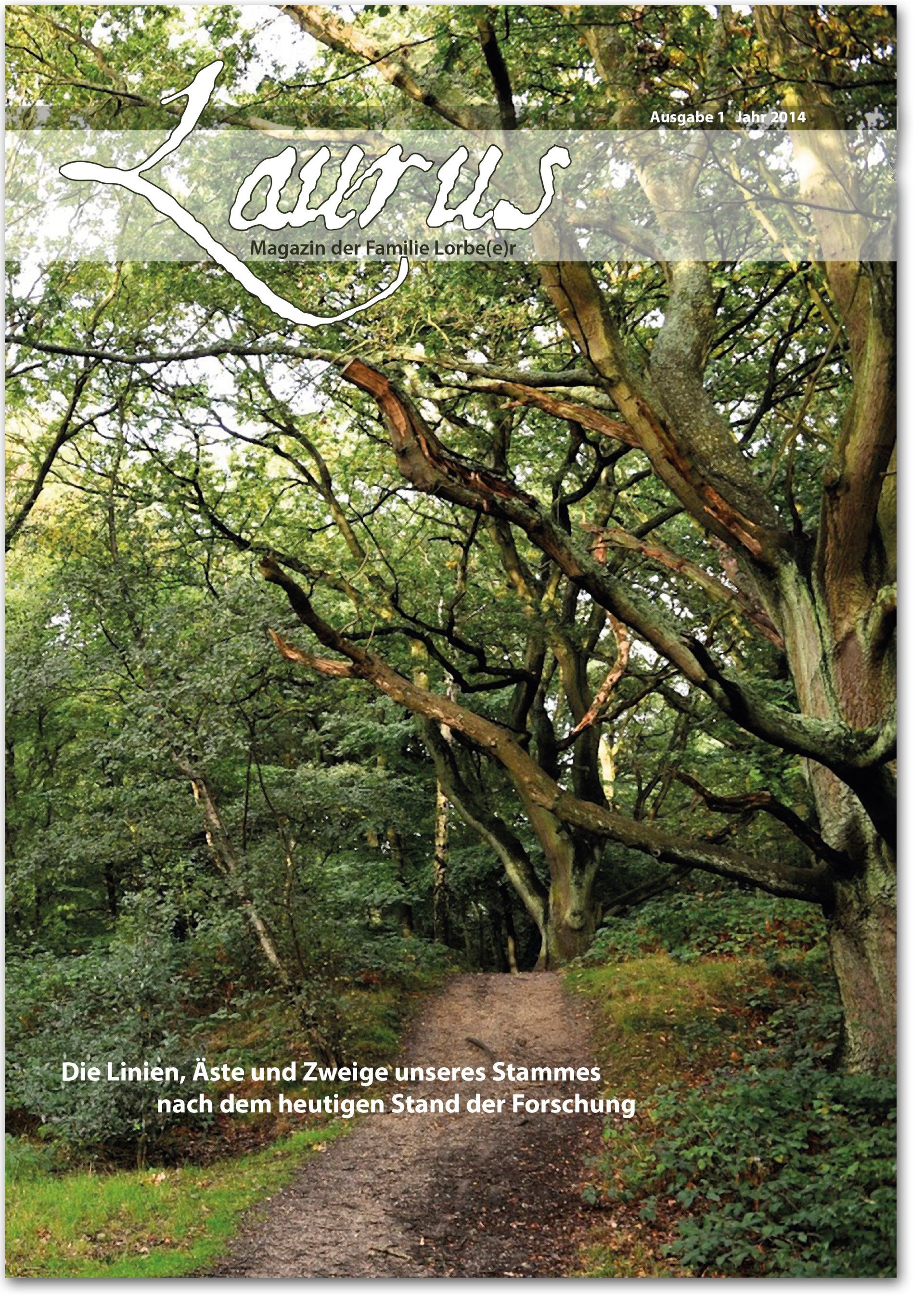Elsässer Stammlinie > Fränkisch-Städtische Linie > Bamberger Adelsast (Lorber von Störchen)
Die Adelsfamilie Lorber von Störchen
shortcut
This "golden branch" originated from the Franconian-urban line
the family through the elevation of the five sons of Pankraz Lorber (1508-1567) then alive granted to Emperor Maximilian II on September 1, 1571 at Speyer.
Progenitor
The foundation stone for the rise of the family was already laid by Clas Lorber (around 1370-1446), who served as prince-bishop's kitchen master, bailiff of the Giechburg, mayor and councilor. During this time he succeeded in building up a property, which enabled his descendants to continuously acquire enough prestige in leading offices in the city and prince-bishops to attain nobility. Two other pillars that have run through generations have certainly contributed to success: on the one hand, legal education (which opened up offices like the district court, as lay judge and mayor, notary and even as chancellor and professors) - on the other hand, clever marriages with other respected and wealthy families like the Haller, Böttinger, Bauer von Heppenstein or Kreß von Kressenstein.
Finally, his great-grandson Pankraz (1508-1567) and his five sons Jobst (1533-1581), Caspar (1537-1578), Eustachius (1542-1571), Pankraz (1544-1587) and Erasmus ( 1546-1576) apply.
Finally, his great-grandson Pankraz (1508-1567) and his five sons Jobst (1533-1581), Caspar (1537-1578), Eustachius (1542-1571), Pankraz (1544-1587) and Erasmus ( 1546-1576) apply.
Werdegang
The title of nobility also enabled the following generations to hold leading positions in the Bamberg monastery. He also opened a continuation of the wise marriage policy to increase prestige and wealth through marriages in other lower noble circles. The family sometimes called itself after their house under the storks (Dominikanerstraße 4) "Lorber von Störchen" - probably also to differentiate them from the middle-class relatives living in the city at the same time.
The family succeeded in not only surviving the Thirty Years' War and the witch hunt, despite the looting and decline of the copper trading yard, but gradually increasing. At the beginning of the 18th century, the council family increasingly became a legal scholar in the prince-bishop's service. This development culminated in Ignaz Christoph von Lorber (1725-1797), who enjoyed a reputation as a lawyer far beyond the borders of the Hochstift and rose to offices that are comparable to a ministry today.
With the end of the independent Bamberg monastery through the takeover by the Kingdom of Baiern in 1802, the family's prominent position also ended. The line ended in the male line with the Royal Bavarian Rittmeister Ignaz Nepomuk von Lorber (1788-1857). His only daughter Marie died as a married baroness of zu Rhein as the last descendant of the family in 1920 in Füssen.
All in all, it can be said that there is no Bamberg family that has been able to stay in the management level of the city and the Hochstift for so long and continuously. She accompanied the fortunes of the city over 400 years and 12 generations. The "Lorbersgasse" is named after her in Bamberg, at the foot of the former Lorberhof.
The family succeeded in not only surviving the Thirty Years' War and the witch hunt, despite the looting and decline of the copper trading yard, but gradually increasing. At the beginning of the 18th century, the council family increasingly became a legal scholar in the prince-bishop's service. This development culminated in Ignaz Christoph von Lorber (1725-1797), who enjoyed a reputation as a lawyer far beyond the borders of the Hochstift and rose to offices that are comparable to a ministry today.
With the end of the independent Bamberg monastery through the takeover by the Kingdom of Baiern in 1802, the family's prominent position also ended. The line ended in the male line with the Royal Bavarian Rittmeister Ignaz Nepomuk von Lorber (1788-1857). His only daughter Marie died as a married baroness of zu Rhein as the last descendant of the family in 1920 in Füssen.
All in all, it can be said that there is no Bamberg family that has been able to stay in the management level of the city and the Hochstift for so long and continuously. She accompanied the fortunes of the city over 400 years and 12 generations. The "Lorbersgasse" is named after her in Bamberg, at the foot of the former Lorberhof.
Outstanding biographies
- Dr. Jobst von Lorber (1533–1581), chancellor of the prince bishop, district court assessor, imperial notary, applied in 1570 together with his brother Pankraz on the edge of the Reichstag to Speyer to raise his family to the nobility;
- Pankraz von Lorber (1544–1587), servant of Archduke Charles of Austria (son of Emperor Ferdinand I), died in Vienna;
- Hans Caspar von Lorber (1560–1626), councilor over 42 terms, including 8 mayors and 1 mayor, survived the witch hunt in contrast to two thirds of the other councils;
- Michael von Lorber (1569–1620), donated a family name book, had to leave Bamberg and emigrate to Zeil and Schweinfurt, respectively, after accepting the Protestant confession;
- Johann Pankraz von Lorber (1587 - around 1644), captain in the Hatzfeld Regiment during the Thirty Years' War;
- Jacob Wilhelm von Lorber (1591–1618), canon of St. Stephan, was killed by the organist of St. Martin in two stings at a wedding;
- Hans Adam von Lorber (1600-1666), son of Michael, mayor of Königsberg in Bavaria;
- Daniel von Lorber (1647-1703), son of Hans Adam, returned to the Catholic faith and once again served the Bamberg prince-bishops as judge and orderly;
- Johann Ignaz Christoph von Lorber (1725–1797), already a professor of law at the age of 24, authored several scientific writings, tomb preserved on the outer wall of the Upper Parish Church;
- Franz Eberhard Christoph Joseph von Lorber (1755-1812), retired until the secularization of Bamberg court and government councilors, with transition to the Kingdom of Baiern;
- Ignaz Nepomuck von Lorber (1788-1857) - Royal Bavarian Rittmeister, last male heir of the family;
- Marie von zu Rhein, born von Lorber (1838-1920), last descendant of the family.
Spread today
According to current knowledge, this part of our family died out in 1920.
The article in the family magazine Laurus
This branch was also covered in the family magazine "Laurus" in 2014. The corresponding article can be downloaded here (PDF in German).
Do not be surprised about deviations from the above text. The article reflects the state of research from 2014. In contrast, the text on the homepage is up to date with family research.
Do not be surprised about deviations from the above text. The article reflects the state of research from 2014. In contrast, the text on the homepage is up to date with family research.
Sources:
Amongst other things ...
- Small family chronicle by Michael von Lorber, started in 1596, Bamberg State Archives G 35.2 No. 360
- Copies from the Great Family Chronicle of Michael von Lorber, started from 1613 to 1703, family property of Ludwig Lorbeer in Vienna
- Various deeds and church records in archives in Bamberg







